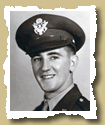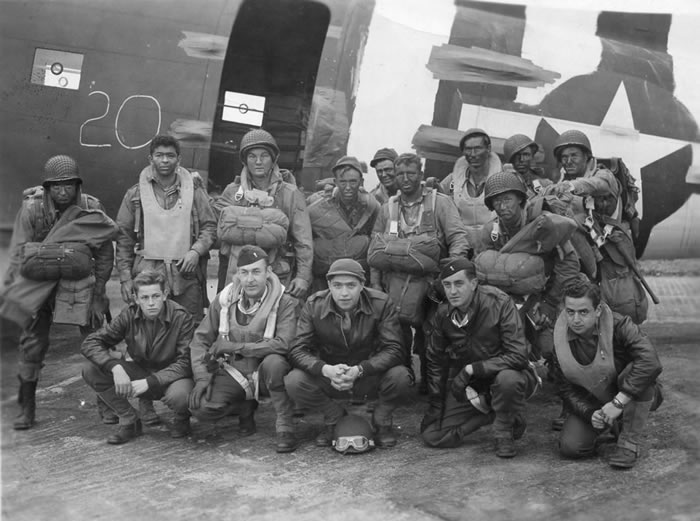| The Assault | Timeline | Maps | Men of D-Day | Photos |

|
14 March 1944--After arriving in England, my crew and I were assigned to the 9th Troop Carrier Pathfinder School and Group Provisional at North Witham Airfield, the Midlands, England. I also picked up a new navigator and a co-pilot. We did extensive training with both American and British paratroopers doing drops; we also trained in formation flying. Our aircraft had radar and specialized navigation equipment; we became so proficient we could drop troop and equipment within a 50-foot radius of a target zone day or night. 6 June 1944--One of our combat missions was the invasion of Normandy in the pre-dawn of 6 June 1944. After that campaign we went wherever we were needed spearheading various operations requiring para-drop and supplies. Our normal altitude for a paradrop was 400 feet which allowed the parachute to fully open just before touchdown. This reduced the period of time the paratrooper would be hanging helpless in a harness and exposed to enemy fire. The downside was the plane was vulnerable to damage from ground fire. (The C47s had no armor or armament and no self-sealing gasoline tanks.) In this instance, D-Day, the damage done was a small hole in the right wing and damage to the left engine which was on fire for a short time. We were able to put it out, however, I had flashbacks of it for years after. June 5, 1944 - North Witham - England
Aircrew (Kneeling, Left
to Right): Paul Francis Graham Egan (Submitted by his daughter Jean, October 12, 2025) My Dad enlisted in 1939 and was first stationed at Schofield Barracks, Pearl Harbor Hawaiian Territory. He trained as an airplane mechanic but was also a licensed pilot and was one of two enlisted men who flew at Pearl Harbor. He survived the Japanese attack on 7 Dec 1941. He had to become an officer once war was declared in order to continue to fly and went to officer training school in Tulare and Lancaster, California before being commissioned. He performed additional training in 1943 on bombers and many other aircraft including cargo planes. He arrived in England in March 1944 and was selected to become a Pathfinder pilot on 9 April 1944, two weeks after he arrived at the 100th Troop Carrier Squadron, 441st TC Group. My Dad was 28 by the time D-Day arrived, quite a bit older than most of the young men who were pilots, but he had a lot of military flying time starting from 1939. His recollections mention other missions including Operation Market Garden and Operation Repulse, the Battle of the Bulge, and moving the 17th Airborne Division from England to France then to Bastogne in very bad weather during December 1944 as well as secret missions in January/February 1945. He notes that in March 1945 the designation of Headquarters for the IX Pathfinder Group was discontinued. The Pathfinder Squadron became independent and functional. April 1945 he states: "We moved our squadron from Chartres to Amiens, France and did operations from that base until 3 June 1945. The organization then moved to Roye, France where it was dissolved on or about 9 July 1945." My Dad flew resupply missions after that within France and between France and England. he returned to the US on 24 July 1945. He stayed in the military until retirement February 1967 including two tours of duty in Korea. Jean Egan October 12, 2025 |
| |

